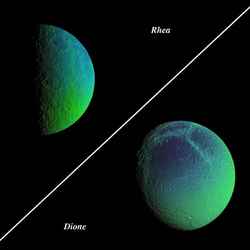
False-color views of Saturn’s cratered, icy moons, Rhea and Dione. Image credit: NASA/JPL/SSI Click to enlarge
Wrapping up a phenomenally successful year of observing Saturn’s icy moons, the Cassini mission is releasing a flood of new views of the moons Enceladus, Dione, Rhea, Hyperion and Iapetus.
The moons and their intricacies are being highlighted at a news briefing today at the American Geophysical Union meeting in San Francisco.
Several new images of Rhea, a moon measuring 1,528 kilometers (949 miles) across, were taken during Cassini’s most recent close flyby on November 26. During the encounter, Cassini dipped to within 500 kilometers (310 miles) of Rhea’s surface.
Additional new images include two “zoomable” mosaics of Rhea and Hyperion at high resolution; false-color views revealing compositional variation on the surfaces of Hyperion, Dione and Rhea; two movies reproducing Cassini’s exciting encounters with Iapetus and Hyperion; and dazzling new images of the plumes of Enceladus, including a time-lapse movie.
The Cassini-Huygens mission is a cooperative project of NASA, the European Space Agency and the Italian Space Agency. The Jet Propulsion Laboratory, a division of the California Institute of Technology in Pasadena, manages the Cassini-Huygens mission for NASA’s Science Mission Directorate, Washington. The Cassini orbiter and its two onboard cameras were designed, developed and assembled at JPL. The imaging team is based at the Space Science Institute, Boulder, Colo.
The image products being released include large mosaics, movies and false-color views. They are available at: http://saturn.jpl.nasa.gov , http://www.nasa.gov/cassini and http://ciclops.org .
Original Source: NASA News Release
